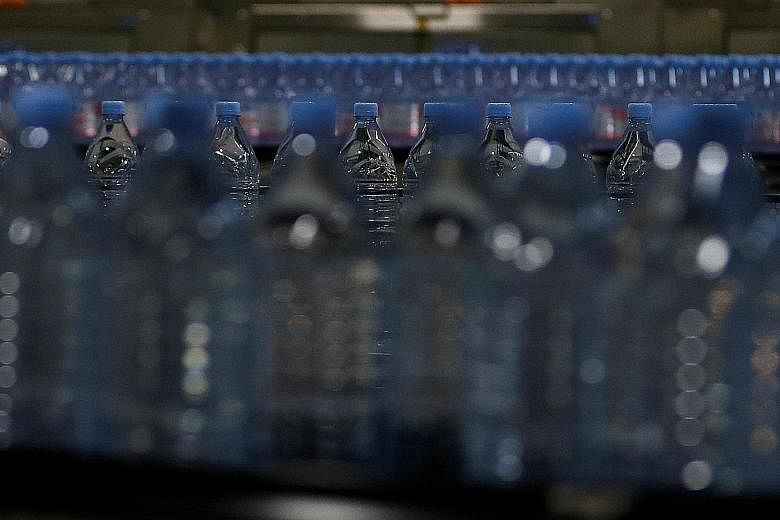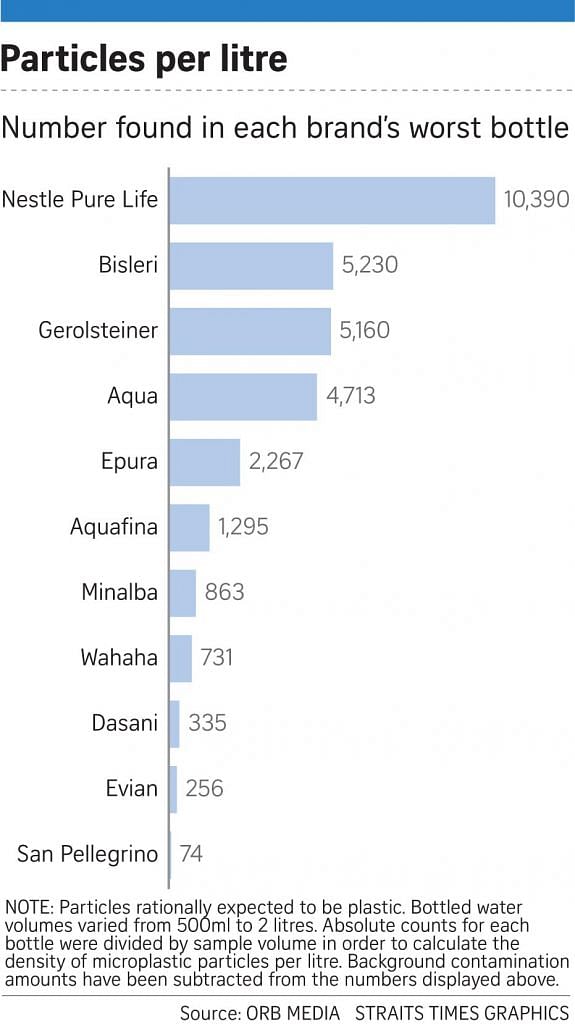MIAMI • Bottled water from the world's leading brands is contaminated with tiny plastic particles that are probably seeping in during the packaging process, according to a major study conducted across nine countries.
"Widespread contamination" with plastic was found in the study, led by microplastic researcher Sherri Mason of the State University of New York at Fredonia, according to a summary released by Orb Media, a US-based non-profit media collective.
Researchers tested 250 bottles of water from 11 different brands in Brazil, China, India, Indonesia, Kenya, Lebanon, Mexico, Thailand and the United States.
Plastic was identified in 93 per cent of the samples, which included major brands such as Aqua, Aquafina, Dasani, Evian, Nestle Pure Life and San Pellegrino.
The plastic debris included polypropylene, nylon, and polyethylene terephthalate (PET), which is used to make bottle caps.
"In this study, 65 per cent of the particles we found were actually fragments and not fibres," Professor Mason said.
"I think it is coming through the process of bottling the water. I think most of the plastic we are seeing is coming from the bottle itself, it is coming from the cap, it is coming from the industrial process of bottling the water."
-
THE STUDY
250
Number of bottles analysed.
9
Countries where tests were carried out - the United States, China, Brazil, India, Indonesia, Mexico, Lebanon, Kenya and Thailand.
11
Number of brands tested.
93%
Proportion of sample bottles found to contain plastic particles.
-
CONSUMPTION
1 million
Bottles of water bought worldwide every minute, according to Euromonitor.
Particle concentration ranged from "zero to more than 10,000 likely plastic particles in a single bottle", said the report.
On average, plastic particles in the 100 micron (0.10 millimetre) size range - considered "microplastics" - were found at a rate of 10.4 plastic particles a litre. Even smaller particles were more common - averaging about 325 a litre.
Other brands that were found to contain plastic particles include Bisleri, Epura, Gerolsteiner, Minalba and Wahaha.
A spokesman for the World Health Organisation (WHO) told The Guardian that although there was not yet any evidence on the impact on human health, it was aware that the issue was an emerging area of concern.
The WHO is to launch a review into the potential risks of plastic in drinking water, reported BBC News yesterday.
Mr Bruce Gordon, coordinator of the WHO's global work on water and sanitation, said that he did not want to alarm anyone, and also emphasised that a far greater waterborne threat comes in countries where supplies can be contaminated with sewage.
He told BBC News that the key question was whether a lifetime of eating or drinking particles of plastic could have an effect.
Previous research by Orb Media has found plastic particles in tap water as well, but on a smaller scale.
"Tap water, by and large, is much safer than bottled water," said Prof Mason. "There are connections to increases in certain kinds of cancer; to lower sperm count; to increases in conditions like (attention deficit hyperactivity disorder) and autism," said Prof Mason.
"We know that they are connected to these synthetic chemicals in the environment and we know that plastics are providing kind of a means to get those chemicals into our bodies."
The three-month study - believed to be the largest investigation of its kind - used a technique developed by the University of East Anglia's School of Chemistry to "see" microplastic particles by staining them using fluorescent Nile red dye, which makes plastic fluorescent when irradiated with blue light.
The results were published on Wednesday.
AGENCE FRANCE-PRESSE


